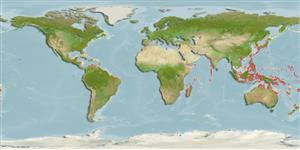Bivalvia |
Lucinida |
Lucinidae
Environment: milieu / climate zone / تغييرات عمق / distribution range
بوم شناسي
; لب شور; تغييرات عمق 0 - 4 m (مرجع 8252). Subtropical
Indo-West Pacific and Western Atlantic: from Red Sea and East Africa, through south east Asia and northern Australia to New Caledonia and Palau Islands. USA and Canada.
Length at first maturity / Size / Weight / سن
بلوغ: Lm ? range ? - ? cm Max length : 7.1 cm SHL جنس نر / بدون خواص جنسي; (مرجع 8252)
Associated with seaward fringe mangroves, where it deeply burrows up to 50 cm into intertidal and shallow subtidal muds and sands (Ref. 77670).
Life cycle and mating behavior
بلوغ | تولید مثل | تخم ریزی | Eggs | Fecundity | Larvae
Members of the class Bivalvia are mostly gonochoric, some are protandric hermaphrodites. Life cycle: Embryos develop into free-swimming trocophore larvae, succeeded by the bivalve veliger, resembling a miniature clam.
مآخذ اصلی
مراجع | هماهنگ كننده | همكاران
Glover, E.A. and J.D. Taylor 2007 Diversity of chemosymbiotic bivalves on coral reefs: Lucinidae (Mollusca, Bivalvia) of New Caledonia and Lifou. Zoosystema 29(1):109-181. (مرجع 8252)
وضعيت در فهرست قرمز IUCN
(مرجع 130435: Version 2025-1)
وضعيت از نظر سايتس (مرجع 108899)
Not Evaluated
Not Evaluated
خطر برای انسان ها
استفاده انسانی
| FishSource |
ابزارها
اطلاعات بيشتر
Trophic EcologyFood items (preys)
تركيب غذايي
مصرف غذايي
شکارچیان
Population dynamicsرشد
Max. ages / sizes
Length-weight rel.
Length-length rel.
نوسانات طولی
Mass conversion
فراواني
Life cycleتولید مثلبلوغFecundityتخم ریزیEggsنمو تخمLarvae PhysiologyOxygen consumption
Human RelatedStamps, coins, misc.
منابع اينترنتي
Estimates based on models
Preferred temperature
(Ref.
115969): 6.4 - 28.9, mean 27.1 (based on 3438 cells).
Fishing Vulnerability
Low vulnerability (10 of 100).
طبقه قيمت
Unknown.
